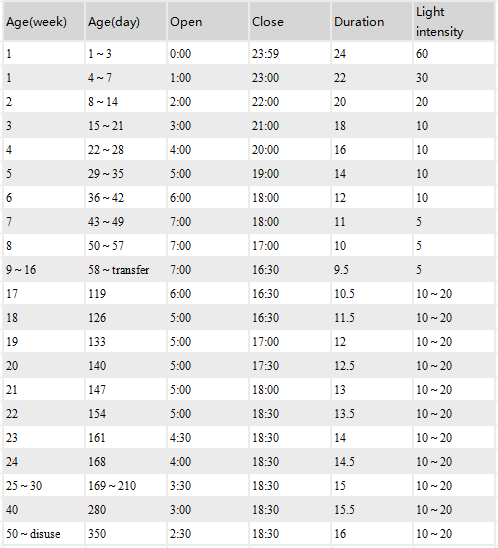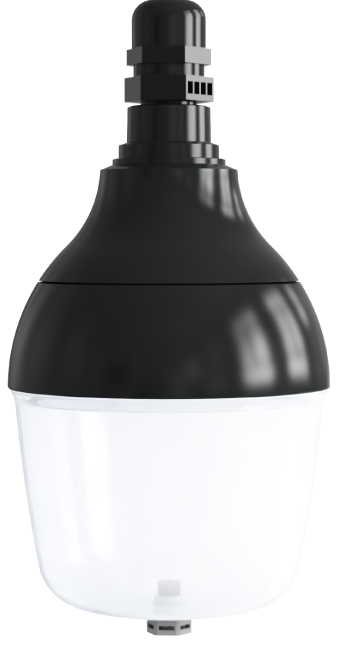Chicken Egg Laying Light Requirements

Directory:
1. The Mechanism of Lighting
2. Lighting Duration Requirements
2.1 Chicks Lighting Duration Requirements
2.2 Hens Lighting Duration Requirements
2.3 Roosters Lighting Duration Requirements
3. Light Intensity Requirements
4. Lighting System for Laying Hens
5. Precautions for Lighting Management
Lighting management is a crucial technology for enhancing the production efficiency of laying hens. In contemporary poultry farming, lighting plays a key role in regulating the sexual maturity of chickens and significantly influences their growth, development, egg-laying timing, egg production, egg weight, eggshell quality, fertilization rates, and the semen volume of roosters. By implementing effective lighting management, the specific lighting requirements of laying hens can be addressed, thereby improving breeding efficiency.
1. The Mechanism of Lighting
In the management of laying hens, lighting not only facilitates access to food and water but also affects the frequency of chicken activity. It plays a critical role in reproduction by influencing sexual maturity, ovulation, and egg-laying. Chickens are believed to have two types of photoreceptors: one in the retina and another in the hypothalamus. Light stimulation reaches the hypothalamus via the optic lobe's neural pathways. Additionally, light can directly impact the pineal gland and hypothalamus through the skull. When stimulated by changes in light, the hypothalamus releases gonadotropin, which travels to the anterior pituitary through the pituitary portal system, triggering the secretion of follicle-stimulating hormone and ovulation-inducing hormone. This process promotes follicle development and ovulation. The matured follicles produce estrogen, which enhances the development and function of the hen's oviduct, leading to the appearance of secondary sexual characteristics such as a larger, redder comb and an open pubic bone. Estrogen also aids in calcium metabolism for eggshell formation, while the ovulation hormone induces ovulation in hens.
2. Lighting Duration Requirements
2.1 Chicks Lighting Duration Requirements
For newly caged chicks, the primary purpose of lighting is to help them acclimate to their environment and locate water and feed quickly. Typically, during the first three days after being placed in the cage (1 to 3 days old), a lighting system with 24 hours of light at an intensity of 60 Lux is used to facilitate adaptation, encourage feeding, and ensure normal weight gain during the transition to a new nutrient supply.
2.2 Hens Lighting Duration Requirements
A well-structured lighting system is essential for controlling the timing of sexual maturity in hens. Generally, hens' sexual organs develop slowly until they reach 7 to 10 weeks of age; after 12 weeks, the weight, volume, and length of the oviduct begin to increase. Providing 10 hours or more of light per day can stimulate sexual maturity in hens. To ensure the timely development of sexual organs, it is typically recommended to maintain a lighting duration of 10 hours between the ages of 10 to 18 weeks.
2.3 Roosters Lighting Duration Requirements
The influence of lighting on roosters primarily affects testicle development and sperm production. There is an inverse relationship between the age at which young roosters start producing semen and the duration of light exposure. Increasing the length of lighting can enhance sperm production, while reducing it can hinder this process. The light's stimulating effect on the testicles is most significant during the early growth phase. It is generally accepted that a minimum of 12 hours of light per day is necessary for optimal testicle growth and high sperm output in roosters. To prevent early maturation in roosters, light exposure should be kept under 12 hours until they reach 18 weeks of age. Since male and female chickens are raised in the same conditions, and 12 hours of light can trigger early maturation in hens, the lighting duration for roosters aged 10 to 18 weeks is typically limited to below 10 hours. Roosters' sexual organs are fully developed by 20 weeks of age, and to ensure a higher sperm yield after this age, they should receive more than 12 hours of light exposure.
chicken egg laying light requirements

3. Light Intensity Requirements
Proper light intensity is crucial for helping newly caged chicks quickly locate water and food and adjust to their surroundings. Chicks thrive best at a light intensity of 5 Lux; however, to assist them in finding water and feed promptly, the light intensity can be increased, but should not exceed 30 Lux. Typically, a light intensity of 30 Lux is used for chicks aged 1 to 3 days. As the chicks grow older, the intensity should gradually decrease to 5 Lux. Dim lighting can lower the flock's activity levels, reducing heat and feed consumption, which maximizes feed efficiency and minimizes pecking behavior. For laying hens, a light intensity of 10 Lux is optimal for achieving the highest egg production rates, while a range of 10 to 20 Lux is commonly used in practice.
4. Lighting System for Laying Hens
The lighting system refers to the specific guidelines for artificial or supplemental lighting provided to chickens during certain periods or throughout their entire growth cycle. This system is a vital technical measure in the production and management of laying hens.
During the growth phase of chicks and the rearing period, the lighting system is designed to promote healthy growth while preventing premature sexual maturity in hens. After reaching 10 weeks of age, prolonged exposure to light can accelerate the development of their reproductive organs, leading to premature sexual maturity, which negatively impacts egg production. Therefore, during this stage, the lighting duration should be kept short or gradually reduced, rather than extended, and the light intensity should remain low. Once the hens enter the egg-laying phase, the lighting duration should be gradually increased to a specific number of hours and then maintained consistently without reduction, and the intensity should not be decreased. This approach supports timely egg-laying and peak production, allowing hens to maximize their egg-laying potential. During peak production, the lighting duration should be at least 14 hours, with stimulation occurring no fewer than 8 times and not exceeding 16 hours. The conventional lighting management system for laying hens is detailed in the accompanying table.
5. Precautions for Lighting Management
5.1 Thoughtful Design of the Lighting System
The design of the lighting system should take into account the growth and development of the chickens. Given the lengthy production cycle of laying hens and the significant influence of light on their performance, it is advisable to create a well-structured and comprehensive lighting system. During the brooding and rearing stages, the focus should be on ensuring adequate access to water and feed to achieve optimal feed conversion rates. To prevent light-induced stimulation and early maturity, the lighting system during these stages should adhere to the principle of "no increase in lighting duration or intensity." Conversely, during the egg-laying phase, to maximize light stimulation, the system should follow the principle of "no reduction in lighting duration or intensity."
5.2 Chicken-Centric Implementation of the Lighting System
The implementation of the lighting system should be flexible and adjusted according to the chickens' physiological development while still adhering to the established principles. It is generally recommended to initiate light treatment at 18 weeks of age. However, if the weight of the chicken group does not meet the required standards, the start can be delayed until 20 weeks of age.
6. Related Product
Chicken Egg Laying Light T5

